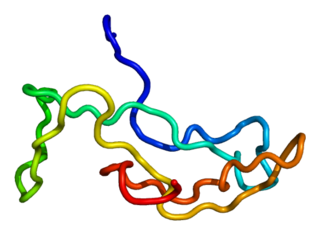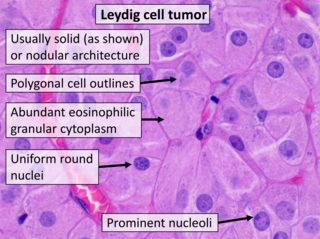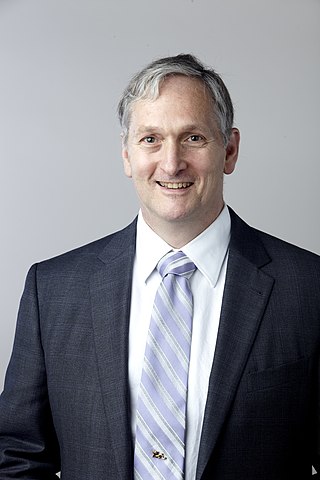Related Research Articles

Haematopoiesis is the formation of blood cellular components. All cellular blood components are derived from haematopoietic stem cells. In a healthy adult human, roughly ten billion to a hundred billion new blood cells are produced per day, in order to maintain steady state levels in the peripheral circulation.

Luteinizing hormone is a hormone produced by gonadotropic cells in the anterior pituitary gland. The production of LH is regulated by gonadotropin-releasing hormone (GnRH) from the hypothalamus. In females, an acute rise of LH known as an LH surge, triggers ovulation and development of the corpus luteum. In males, where LH had also been called interstitial cell–stimulating hormone (ICSH), it stimulates Leydig cell production of testosterone. It acts synergistically with follicle-stimulating hormone (FSH).

Leydig cells, also known as interstitial cells of the testes and interstitial cells of Leydig, are found adjacent to the seminiferous tubules in the testicle and produce testosterone in the presence of luteinizing hormone (LH). They are polyhedral in shape and have a large, prominent nucleus, an eosinophilic cytoplasm, and numerous lipid-filled vesicles.

Sertoli cells are a type of sustentacular "nurse" cell found in human testes which contribute to the process of spermatogenesis as a structural component of the seminiferous tubules. They are activated by follicle-stimulating hormone (FSH) secreted by the adenohypophysis and express FSH receptor on their membranes.
Thomas A. Reh is an American scientist and author.
Douglas A. Melton is an American medical researcher who is the Xander University Professor at Harvard University, and was an investigator at the Howard Hughes Medical Institute until 2022. Melton serves as the co-director of the Harvard Stem Cell Institute and was the first co-chairman of the Harvard University Department of Stem Cell and Regenerative Biology. Melton is the founder of several biotech companies including Gilead Sciences, Ontogeny, iPierian, and Semma Therapeutics. Melton holds membership in the National Academy of the Sciences, the American Academy of Arts and Sciences, and is a founding member of the International Society for Stem Cell Research.

WNT4 is a secreted protein that, in humans, is encoded by the WNT4 gene, found on chromosome 1. It promotes female sex development and represses male sex development. Loss of function may have consequences, such as female to male sex reversal.
Testicular Immunology is the study of the immune system within the testis. It includes an investigation of the effects of infection, inflammation and immune factors on testicular function. Two unique characteristics of testicular immunology are evident: (1) the testis is described as an immunologically privileged site, where suppression of immune responses occurs; and, (2) some factors which normally lead to inflammation are present at high levels in the testis, where they regulate the development of sperm instead of promoting inflammation.

Kaptin is a protein that in humans is encoded by the KPTN gene.

Inhibin, beta B, also known as INHBB, is a protein which in humans is encoded by the INHBB gene. INHBB is a subunit of both activin and inhibin, two closely related glycoproteins with opposing biological effects.

Epiandrosterone, or isoandrosterone, also known as 3β-androsterone, 3β-hydroxy-5α-androstan-17-one, or 5α-androstan-3β-ol-17-one, is a steroid hormone with weak androgenic activity. It is a metabolite of testosterone and dihydrotestosterone (DHT). It was first isolated in 1931, by Adolf Friedrich Johann Butenandt and Kurt Tscherning. They distilled over 17,000 litres of male urine, from which they got 50 milligrams of crystalline androsterone, which was sufficient to find that the chemical formula was very similar to estrone.

Matthew P. Scott is an American biologist who was the tenth president of the Carnegie Institution for Science. While at Stanford University, Scott studied how embryonic and later development is governed by proteins that control gene activity and cell signaling processes. He co- discovered homeobox genes in Drosophila melanogaster working with Amy J. Weiner at Indiana University.
Bruce Lahn is a Chinese-born American geneticist. Lahn came to the U.S. from China to continue his education in the late 1980s. He is the William B. Graham professor of Human Genetics at the University of Chicago. He is also the founder of the Center for Stem Cell Biology and Tissue Engineering at Sun Yat-sen University in Guangzhou, China. Lahn currently serves as the chief scientist of VectorBuilder, Inc.

Leydig cell tumour, also Leydig cell tumor, (testicular) interstitial cell tumour and (testicular) interstitial cell tumor, is a member of the sex cord-stromal tumour group of ovarian and testicular cancers. It arises from Leydig cells. While the tumour can occur at any age, it occurs most often in young adults.

Clifford James Tabin is chairman of the Department of Genetics at Harvard Medical School.
Everett Peter Greenberg is an American microbiologist. He is the inaugural Eugene and Martha Nester Professor of Microbiology at the Department of Microbiology of the University of Washington School of Medicine. He is best known for his research on quorum sensing, and has received multiple awards for his work.

Richard Paul Harvey is a molecular biologist, the Sir Peter Finley professor of Heart Research at the University of New South Wales and Deputy Director and Head of the Developmental and Stem Cell Biology Division at the Victor Chang Cardiac Research Institute.

A spermatogonial stem cell (SSC), also known as a type A spermatogonium, is a spermatogonium that does not differentiate into a spermatocyte, a precursor of sperm cells. Instead, they continue dividing into other spermatogonia or remain dormant to maintain a reserve of spermatogonia. Type B spermatogonia, on the other hand, differentiate into spermatocytes, which in turn undergo meiosis to eventually form mature sperm cells.

Vassilios Papadopoulos, DPharm, PhD, DSc (hon), born February 18, 1961, in Athens, Greece, is a scholar, researcher, inventor, professor, and university administrator who has served as dean of the USC Alfred E. Mann School of Pharmacy and Pharmaceutical Sciences at the University of Southern California in Los Angeles, California, since 2016. Previously, he was the associate vice president and director of the Biomedical Graduate Research Organization at Georgetown University from 2005 to 2007, and the executive director and chief scientific officer of the Research Institute of the McGill University Health Center from 2007 to 2015.
Thomas S. K. Chang (1948-1996) was an American reproductive biologist. He was born in Hawaii in 1948, and earned a bachelor's degree and Ph.D. from the University of Hawaiʻi in 1970 and 1976. In 1977, he came to The Johns Hopkins School of Hygiene and Public Health to carry out his postdoctoral studies. In 1981, he joined the Department of Urology of The Johns Hopkins School of Medicine to carry out his postdoctoral studies. His studies focus on male infertility in relationship to sperm physiology and endocrinology.
References
- 1 2 3 4 Barry R Zirkin; Peter Schlegel; Bernard Robaire; Sally Perreault (2008). "In Memoriam Matthew P. Hardy, Ph.D. 1957–2007". Biology of Reproduction . 78 (3): 563–564. doi: 10.1095/biolreprod.108.067983 .
- ↑ Matthew P Hardy; Barry R Zirkin; Larry L Ewing (1989). "Kinetic studies on the development of the adult population of Leydig cells in testes of the pubertal rat". Endocrinology . 142 (2): 762–70. doi:10.1210/endo-124-2-762. PMID 2912699.
- ↑ Dong L, Jelinsky SA, Finger JN, Johnston DS, Kopf GS, Sottas CM, Hardy MP, Ge RS (December 2007). "Gene expression during development of fetal and adult Leydig cells". Annals of the New York Academy of Sciences . 1120 (1): 16–35. Bibcode:2007NYASA1120...16D. doi:10.1196/annals.1411.016. PMID 18184909. S2CID 25978550.